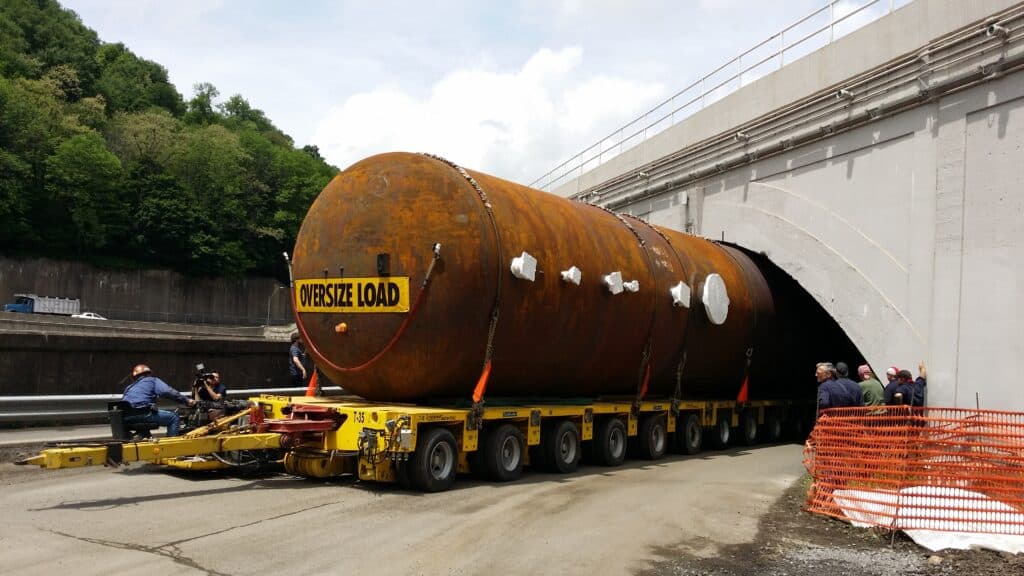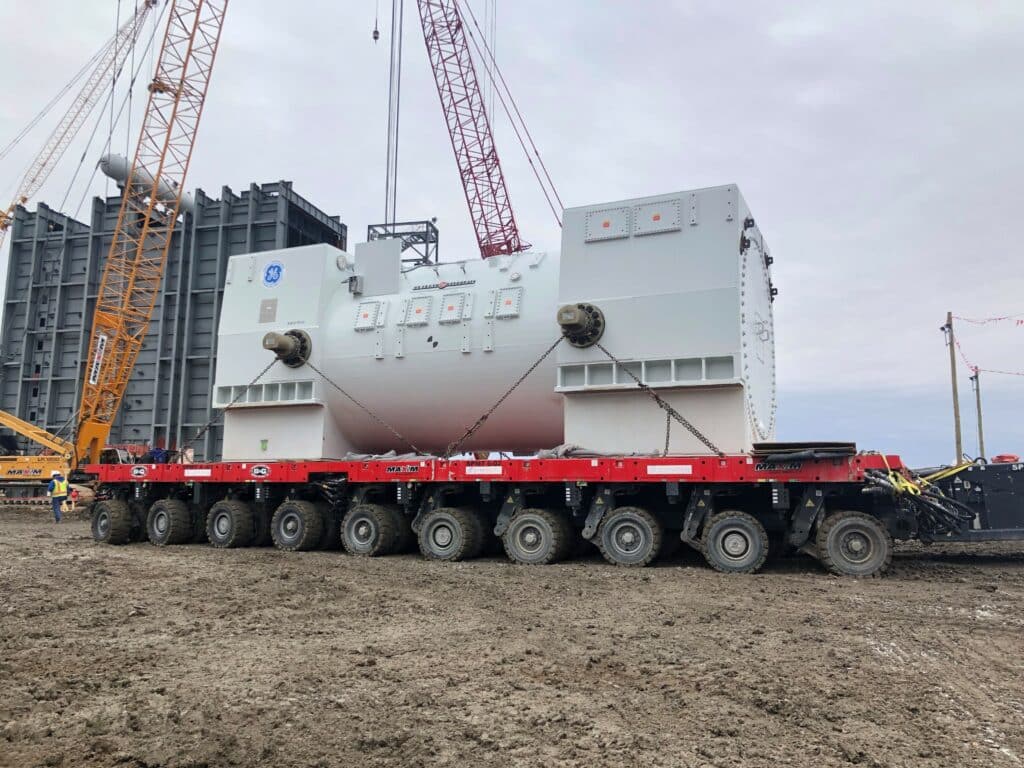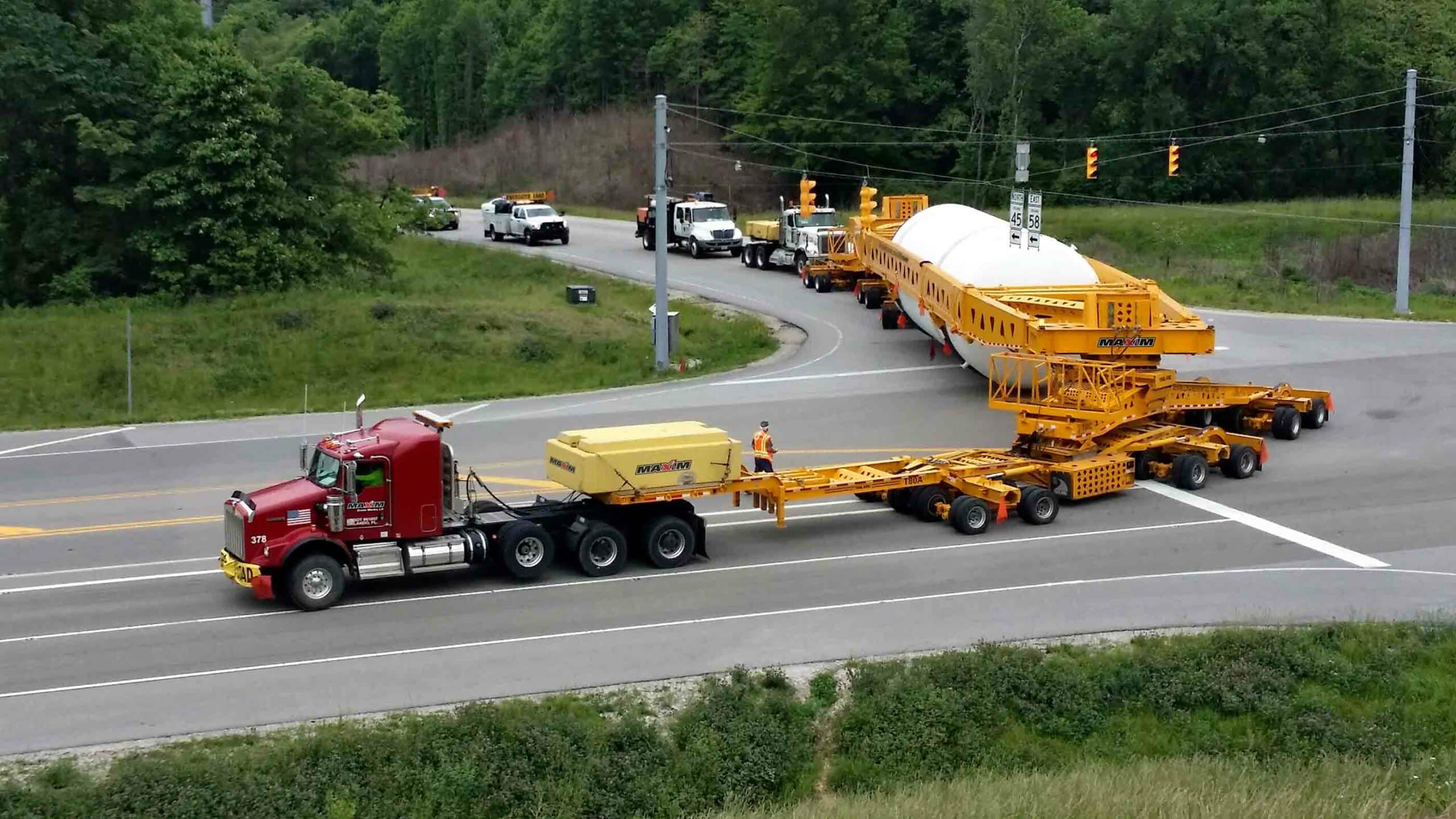Moving exceptionally large and heavy components—often referred to as mega transport or super-heavy hauling—is a complex logistical puzzle demanding meticulous planning across several fronts. While factors like route surveys and permitting are critical, the selection of the precisely correct transport equipment often stands as the linchpin for success, directly impacting feasibility, efficiency, and compliance. This is especially true for intricate site hauling and local transportation logistics, handling Just-In-Time (JIT) deliveries from project sites or intermediate hubs like rail sidings, barge landings, and marine terminals.
At Maxim Crane, we understand that mega transport integrates specialized hauling with lifting, rigging, and engineering. Central to this is ensuring the chosen trailers or transporters perfectly match the load, the route, and the operational requirements. Let’s explore the key steps, paying close attention to how they inform the crucial equipment selection process.
Understanding the Scope of Heavy Cargo Logistics: Setting the Stage for Equipment Needs
Successfully moving enormous components involves understanding the entire journey, but the final stages—navigating from a nearby staging area or logistical hub to the precise installation point—often present the most concentrated set of challenges. This localized movement requires a specific focus and planning distinct from long-haul transportation, immediately beginning to shape the requirements for the transport system.
Defining the Challenge: Site Hauling and Local Transport Focus
Mega transport often involves delivering components to a site or nearby logistical hub (e.g., rail sidings or barge landings) well in advance, where they are stored until needed. For Just-In-Time (JIT) delivery to the final installation point, specialized site heavy haulers, such as modular platform trailers or self-propelled modular transporters (SPMTs), are typically used to self-load and transport these components. This final leg requires careful assessment of site conditions, available space, and ground-bearing capacity to select equipment that ensures precise, efficient delivery under constrained local conditions.
The Importance of Combined Transport Methods
Often, the most efficient strategy involves using multiple transport modes (ship, barge, rail) to deliver major components as close to the final destination as possible. This minimizes complex road transport, but the transition points and the final road segment demand equipment capable of handling the load under potentially constrained local conditions.
Identifying Key Barriers: Constraints Shaping Equipment Choice
Planning local or site transport requires a thorough assessment of potential barriers that not only restrict routes but fundamentally dictate what kind of equipment can be used:
- Natural Barriers: Rivers, wetlands, and mountainous terrain might necessitate equipment with specific axle configurations or enhanced traction capabilities to navigate challenging ground conditions.
- Manmade Barriers: Bridges (with specific load limits per axle configuration), tunnels (height/width limits), and narrow urban streets directly constrain trailer dimensions, length, and weight distribution capabilities.
- Overhead/Underground Utilities: Clearance requirements (power lines) influence the maximum transport height (load + trailer), while underground utilities (culverts, pipelines) impose ground pressure limitations, favoring equipment that distributes weight over a larger area or more axles.
These factors move beyond simple routing; they are primary inputs for determining the necessary equipment specifications.

Step 1: Assessing Sizing and Weight Requirements – The Foundation for Equipment Selection
Accurately defining the load’s dimensions, weight, and center of gravity is the absolute starting point for equipment choice. Regulations also play a huge role here.
- State-Specific Thresholds: Differing state definitions for “over-dimensional” or “superload” impact permitting and directly influence allowable trailer types and configurations.
- Weight Tiers Dictating Equipment Class:
- Loads approaching 200,000 lbs GCW typically push beyond standard trailers, requiring specialized conventional heavy haul trailers with more axles or stronger frames.
- Loads nearing 300,000 lbs GCW frequently mandate dual-lane specialized trailers for highway travel, essential for distributing weight sufficiently to meet bridge and pavement regulations.
- Axle Spacing & Load Distribution: The difference between conventional tandem-axle spacing (~4′ 6″) and common modular platform multi-axle spacing (~4′ 11″ or more) is critical. Modular trailers distribute weight more continuously, which is vital for crossing sensitive structures but requires specific analysis by engineers – a key factor in why this equipment is chosen for superloads.
Step 2: Detailed Route Survey and Planning – Validating Equipment Feasibility
Meticulous route planning validates whether the theoretically suitable equipment can actually navigate the path.
- Comprehensive Surveys & Risk Management: Surveys must confirm physical clearances (width, height), turning radii capabilities (matching trailer articulation), grade percentages (requiring sufficient prime mover power +/- push trucks), and ground conditions. Anticipating obstructions and having contingency plans often involves considering alternative equipment options or support systems.
- Engineering Reviews and Permits: Permit applications based on specific transport designs (including the chosen equipment’s specs: axle loads, spacing, dimensions) are scrutinized by engineers. Bridge and pavement analyses may approve one type of trailer configuration but reject another for the same load on the same route.
- Navigating Terrain and Environment:
- Mountainous Terrain: Directly influences prime mover selection and the potential need for auxiliary power (push/pull trucks), matched to the chosen trailer’s rolling resistance.
- Urban/Suburban Logistics: Tight intersections demand specific trailer steering capabilities (manual). Overhead utility management might limit overall height, influencing trailer deck height choices. Escort requirements are often tied to the specific dimensions of the chosen transport configuration.
- Mastering the Permit Maze: The permitting process is deeply intertwined with equipment choice. Approvals often specify allowable axle weights, spacings, and overall dimensions, effectively dictating the required transport system.
Step 3: Selecting the Right Transport Equipment – The Core Decision
This is where the data from sizing, routing, and barrier analysis converges. The goal is to choose a system that can physically handle the load across the planned route, considering specific constraints.
- Matching Equipment to the Task:
- Specialized Conventional Trailers: Used when loads exceed standard limits but may still fit within certain dimensional envelopes or bridge formulas, often for weights up to the ~200k lbs range.
- Dual-Lane Highway Trailers: Essential for loads typically exceeding ~300k lbs on public roads, providing necessary width and axle numbers for weight distribution according to strict state regulations.
- Modular Platform Trailers (Towable): Highly versatile for very heavy loads. Options like West Coast style platforms (using perimeter beams) or standard modular platforms offer configurable length and high capacity. Their suitability depends heavily on route specifics (especially turning radii) and state allowances for modular configurations (sometimes requiring dual-lane setups even with towable modules).
- Self-Propelled Modular Transporters (SPMTs): The ultimate solution for extreme weights and site maneuverability. Ideal for off-road/project site moves due to low speed and high maneuverability using hydraulic steering. While usable on public roads, permitting is complex due to speed, size, and intense engineering review. Ground pressure exerted by SPMTs is also a key consideration for site moves.
- Critical Decision Factors: Beyond just weight and route, selection involves:
- Maneuverability: Can the trailer configuration navigate tight turns identified in the survey?
- Ground Bearing Pressure: Is the ground/pavement along the route (especially on-site) capable of supporting the pressure exerted by the tires/axles?
- Load Distribution: Does the axle configuration meet specific bridge formula requirements or permit stipulations?
- Loading/Unloading Compatibility: Does the trailer deck height and type match the planned loading/unloading method (crane access, self-offload capability)?
Crucially: The nuances between these equipment types, their specific capabilities, limitations, and regulatory implications demand real practical experience. Partnering with an experienced provider is vital, especially when complex modular systems are required.
Step 4: Efficient Loading, Transport, and Delivery – Executing the Equipment Plan
The chosen equipment directly dictates how loading and unloading occur.
- Loading Methods Linked to Equipment:
- Conventional Trailers: Generally require external lifting (cranes, forklifts). The trailer design must allow access for this equipment and often needs specialized rigging solutions suited to the cargo and trailer tie-down points.
- Modular Platform Trailers/SPMTs: Often feature hydraulic suspension allowing self-loading/offloading using support stands. This “crane-less” method is highly efficient on project sites but requires careful planning regarding stand placement, ground stability, and potential specialized rigging interfaces on the cargo itself. The equipment’s hydraulic capabilities are a key reason for its selection in these scenarios.
Efficient JIT delivery relies on the seamless integration of the transport equipment’s capabilities with site conditions and offloading plans.
Step 5: Partnering with Heavy Haul Experts – Navigating Equipment Complexity
Mega transport logistics are multifaceted, but navigating the complex world of specialized transport equipment is a significant challenge demanding seasoned professionals. Choosing between conventional, modular, or self-propelled systems, understanding their specific performance characteristics, a focus on regulatory compliance, and integrating them into the overall plan requires specialized knowledge.
Effective execution also hinges on seamless coordination and communication between all parties, centered around the capabilities and constraints of the chosen transport system. Managing interactions with authorities, utilities, and site teams regarding the specific equipment being used is critical.

Maxim Crane: Your Integrated Logistics Partner
Maxim Crane provides comprehensive solutions integrating heavy hauling – particularly in equipment selection and operation – with our core capabilities in crane rental, specialized rigging, and project engineering. Our nationwide network and diverse fleet, including a wide range of specialized transport equipment alongside cranes, allow us to tailor the right solution. We manage the complexities of analyzing the load, surveying the route, selecting the optimal equipment, handling permits, assisting with stakeholder coordination, and executing the move.
Don’t let equipment selection uncertainties jeopardize your project. Contact Maxim Crane today to leverage our deep experience in heavy transport technology so your components are moved efficiently and effectively using the ideal system for the job.


